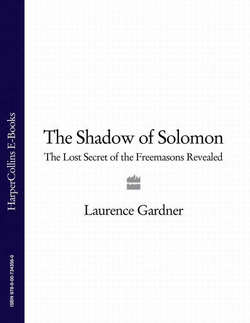Читать книгу The Shadow of Solomon: The Lost Secret of the Freemasons Revealed - Laurence Gardner - Страница 16
The Key
ОглавлениеThe net product of all this research into the origins and history of post-1688 English Freemasonry is that it is about as weak and insubstantial as it could possibly be. Taken chronologically, the story begins with the biblical metal-worker Tubalcain of Mesopotamia (c. 3500 BC) and the wisdom of his father Lamech—a story that incorporates the later Hermes Trismegistus (Thoth of Egypt), and eventually the Greek philosopher Pythagoras.
From Tubalcain and his siblings, the history skips to King Nimrod of Babylon, who apparently instituted the masonic Charges (c. 3000 BC), and then leaps 1,000 years to Abraham, who somehow met with Euclid (c. 300 BC) in Egypt. Moving from Egypt to Israel with Moses (c. 1360 BC), we arrive with the Dionysian Artificers and Hiram of Tyre, who built Solomon’s Temple in Jerusalem (c. 950 BC). After that we are in England with St Alban (AD c. 260); then with King Charles II of France (c. 850), and back again to England with Prince Edwin of York (c. 926), and King Athelstan of Mercia (c. 930).
At the end of all this, there is the unfortunate Sir Isaac Newton trying to fathom what he can from this chaotic mire. And to cap it all, James Anderson—the man responsible for most of the chaos—admits that there were no legitimate records to speak of, but then lays the blame for the lack of available literature on the recently deceased Sir Christopher Wren!
Whether the stories of Tubalcain, Nimrod, Athelstan and the others are correct or not is of no real consequence. There is, in fact, a measure of historical substance in some aspects—but these are all accounts of operative artificers, craftsmen and builders. Chronologically, the last account in the series of tales is that of King Athelstan and his stonemasons. Then, quite suddenly, around 800 years later there emerges a charitably based group of nobles and businessmen who support boys’ and girls’ educational foundations and meet in taverns. Nothing, it seems, happened in between, except that the latter fraternity was said to have inherited its secret signs and passwords from the former.
Something is drastically wrong here. There would be small likelihood of high-ranking nobility becoming involved in a tavern club with such little substance or pedigree. Nor indeed would Prince Edward, Duke of Kent, and Prince Augustus, Duke of Sussex, (the sons of King George III) have taken positions as Grand Masters of the Antients and Moderns respectively if Freemasonry were just an everyday fraternity of moralists and benefactors.
James Anderson said at the outset that the meaningful records had been lost when the Stuarts were exiled. So that is the key to understanding the real course of events. King George I was the son of Electress Sophia of Hanover. She was the daughter of Frederick V, Elector Palatine of the Rhine, whose wife was Elizabeth Stuart, a daughter of King James I (VI). John Wilkins, chaplain to the Palatinate in the middle 1600s had been the man who had founded the masonic group that became the Royal Society of King Charles II, for which Isaac Newton later became president in 1703. Another original founder of that Society was its professor of astronomy, Sir Christopher Wren.
Being the grandson of Frederick and Elizabeth, Britain’s King George I was well aware that there were masonic traditions in the maternal branch of his family, but they had not formed part of his Hanoverian education. His successors were also conscious of the heritage, but they were similarly unaware of the detail. Their only hope of discovery rested with Christopher Wren, who did not die until 1723—the year of the first Anderson Constitutions.
What Anderson really meant when he blamed Christopher Wren for the chaotic state of English Freemasonry was not that Wren had been responsible for losing anything—but that Wren’s loyalties were not with the new Hanoverian establishment. They were with the Stuarts and the Palatinate. Anderson was convinced that Wren, a founder member of the Royal Society, was fully aware of secrets that the Hanoverian fraternity wanted to know—but he died without revealing anything.
